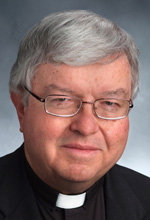Q. Why do Catholics kiss the pope’s ring? Did our Lord walk around with such a ring? I don’t know whether our new Pope Francis has had a ring designed for himself. It seems that he is trying to live the simple apostolic life. (For that, he is making news both in Catholic and in secular circles, and it seems that he was sent just at the right time.) (Jamestown, Ky.)
A. For centuries, popes have worn a ring called the fisherman’s ring. It shows an image of Peter, the first pope, marking Peter’s original occupation and Christ’s invitation to the first apostles to become “fishers of men.”
Until 1842, the ring was used to stamp official papal decrees in wax as a sign of their authenticity, a fact reflected in the present-day symbolic destruction of a pope’s ring at his death or resignation.
Characteristic of Pope Francis’ preference for modesty, the new pope’s ring is actually not one newly designed at his election. The wax model for it was created decades ago for Pope Paul VI.
Though a ring itself was never produced at that time, Paul VI’s priest-secretary kept the wax model, and sometime later it was cast in gold-plated silver. When he was shown the “leftover” ring, Pope Francis chose it as his own.
Bishops, too, wear a ring that is presented to them in their ordination ceremony as a symbol of their “fidelity to and nuptial bond with the church.”
When people kiss a bishop’s ring (a practice seen less frequently these days and often replaced by a simple handshake), they are expressing their respect for the bishop’s role and responsibility in guiding the church.
Q. I am an 82-year-old woman who lives alone. I would like very much to have a deeper relationship with God.
I pray and meditate on the rosary and, although I have several booklets with devotional prayers in them, those prayers seem to be very short and not enough to satisfy me. I have heard of the Liturgy of the Hours and the Divine Office, but I am not familiar with them.
Do they require that certain prayers be recited at particular hours in the day? (I still have to run errands, go grocery shopping, etc., and wonder whether I could keep to a specific regulated schedule.) (Albany, N.Y.)
A. The Liturgy of the Hours, the Divine Office and the breviary all refer to the same thing — namely, an official set of prayers that is required to be recited by members of the Catholic clergy and monastic communities.
Consisting of psalms, hymns and readings, they are part of the public prayer life of the church and are offered at various times to sanctify the day. The Divine Office has a long history in the church. The earliest Christians tended to continue the Jewish practice of reciting prayers at certain hours of the day and night.
With the reform of Pope Paul VI following the Second Vatican Council, the Liturgy of the Hours consists of morning prayer, daytime prayer (divided into midmorning, midday or midafternoon), evening prayer and night prayer.
Monastic communities gather in their chapel at certain times throughout the day, while secular clergy tend to pray the office individually, fitting it at their own convenience into their other pastoral responsibilities.
I admire your desire for a deeper prayer life and encourage your efforts. I believe, though, that to take on the entire Divine Office might become too burdensome for you. What many of the laity have found helpful instead, and what I would recommend, is a publication called Magnificat (you can request it via this toll-free telephone number: 1-866-273-5215).
You are mailed a monthly booklet, which, for each day, includes morning prayer, evening prayer and the Mass texts for that day, together with some brief additional devotional readings.
The entire text can be read and prayed in about 20 minutes, and it can be done at any point in the day, depending on your schedule.
***
Questions may be sent to Father Kenneth Doyle at askfatherdoyle@gmail.com and 40 Hopewell St., Albany, N.Y. 12208.
PREVIOUS: Pope at audience: Americas, open your arms to poor, immigrants, unborn
NEXT: Grandmom wants to take on religious education herself




Thank you for addressing the Liturgy of the Hours. I pray the Liturgy of the Hours daily via the full breviary. In fact, praying the Divine Office was the incentive to my being received into the Catholic Church. Having grown up in Judaism, I’m familiar with having set times of daily prayer. When first learning the Liturgy of the Hours, I was greatly impressed by the Catholic Church following the Jewish daily prayer tradition, especially making the Psalms the backbone of the Church’s official prayer. For your letter writer, praying the Morning and Evening Prayers is a good start, as is Compline (Night Prayer). Magnificat is only one of several good magazines offering Morning and Evening prayers, albeit an abbreviated version of the actual Divine Office. I much prefer the “Living With Christ” magazine. If the letter writer has access to a computer, Universalis.com and DivineOffice.org are two websites offering the daily prayers that matches the breviary, with DivineOffice.org also providing audio, besides the printed.